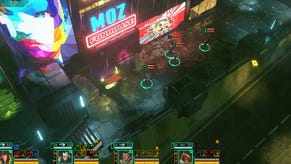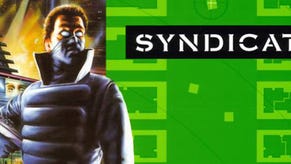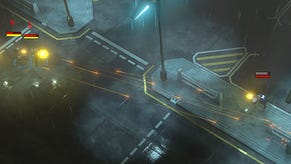Wot I Think: Satellite Reign
When it pours
When I consider Satellite Reign [official site] as a whole, a grand canvas spattered with raindrops, neon and bulletholes, I'm in love with it. Yes, it looks and feels a little like Syndicate, but 5 Lives' Kickstarted RTS-RPG does not slavishly follow a model from the past. Its city is open, a series of district-hubs with opportunities and mission locations scattered across them, and there are many possible routes to victory.
Satellite Reign is, from the wide-scan satellite's view, a thing of beauty and promise. But I've been down in the streets for the last few days to take a closer look at the city. Here's wot I think.
To be wholly immune to the big picture of this cyberpunk cityscape, you'd have to be indifferent to the influences that are fused into the environment. Syndicate, yes, but also Gibson, Bladerunner, Mœbius and Otomo. It's natural that a game set within a city that is such a convincing rendition of electric dreams made solid would instantly appeal to a huge swathe of those who have grown up with or recently embraced these particular flavours of science fiction.
Considered from street-level, where the citizens as well as the city itself must convince, Satellite Reign isn't quite as impressive. My team of agents look more like the crowd of thirty-something punk-by-night office workers who were hanging onto their youth by hanging around with teenagers at Jilly's Rockworld back in the day. Over-eager cosplayers looking to make their outfits pop rather than corporate agents engaging in a bloody battle for supremacy. That'd be fine if their dress sense helped them to mingle with the crowd but most inhabitants of Reign's city look like drones rather than disco-goths.
It's a small pill to swallow, that disconnect between place and (Hiro) protagonists, but together with some of the more fiddly aspects of the tactical combat and stealth, it prevented Satellite Reign from settling down as smoothly as I had hoped it would. As with the aesthetics, the widescreen, zoomed out view is of a game I admire, but the finer details are often frustrating and repetitive. The hours I've spent with it have been mostly enjoyable but many of the minutes within those hours have been spent on a form of autopilot.
At those times - when I feel I'm going through motions that I've learned rather than reacting to the motions of the AI and the setup of the security forces – Satellite Reign feels amiable rather than tense or exhilarating. There's a comfort zone to be found in the calm between missions and even the occasional infiltration can seem like a sedate by-the-numbers operation. That's not to say there aren't moments of anxiety as the security of a site rises and hacked cameras tick back into action, but the more I play, the more often I find myself making challenges for myself, either by leaving members of my crew behind or setting artificial limits on the equipment and augs I'll use on a specific mission.
The beauty of the game is that it allows you to play however you fancy. Want to take a solitary agent on a bank job using nothing but hacking skills and a silenced pistol? Smashing. And maybe you'd like to kick in the front door of a rival corp's headquarters and mow every guard and employee down with a quartet of heavy weapons? As long as your eventual goal involves murder and/or theft, the city is your oyster, and you are Walrus and Carpenter Incorporated.
Satellite Reign is almost as much an open world urban crime game as a cyberpunk corp-war simulator. Your main mode of expression, as CEO-Commander of your agents, involves robbery, targeting ideas as well as cash. An introductory video, in the form of a news-flash montage, tried to make me care about the various entities and technologies of the world, but I found myself attached to the reference points rather than the creation itself. The central concept that differentiates this possible future from the others that it resembles is a form of information age resurrection technology, fused into the game's mechanics through the presence of Relay Beacons. They're checkpoint, respawn point, shop and equipment storage centre rolled into a single location, and they function as a link to the always off-screen HQ that supplies, trains and rebuilds your agents. Those agents are always either in the city or dead. If you decide to work solo, or with anything less than the full squad of four, the agents left behind will stand in the street waiting. They have no home.
I didn't get along with the respawning. It's not that it makes the game too easy; as I've already mentioned, the flexibility of approach allows for on the fly modification of the difficulty level. Being able to download an agent's build into a replica body after 'death' reduces the consequences of risks taken though, and also reduced my attachment to individual characters. Even though there are plenty of ways to mould each agent, they neatly slot into classes and I came to treat them more as highly specialised and powerful RTS-style units rather than characters.
A function of the open world and Relay Beacons is to make all things disposable. There's rarely an impetus to act and while it's easy to appreciate the breathing room when there's such a rich location to explore during downtime, I found myself in need of distractions. Even late in the game, I didn't feel as if my success or failure had any real impact – agents respawn, districts go on much as they were before the bullets flew, and missions are separate constructs, plugged into but outside the city.
Picking and choosing equipment before heading into a mission area is compelling and the interface mostly works beautifully to support whatever approach is chosen. Agents attach to cover and the UI informs you as they do so, a predictive overlay on the screen helping to ensure that a slight misclick won't ruin your day. Combat involves a few too many bullet-sponges for my liking but I understand and appreciate the reasoning – the ability to endure exposure to gunfire allows for tactical adjustments during shoot-outs, as well as preventing every failed attempt at stealth from ending in immediate disaster.
Perhaps it's greedy to wish that such a beautiful city was more reactive and that my own actions in it would leave persistent signs of change. I referred to it as a canvas at the start of this review and that's precisely how I came to think of it – it exists to be acted upon and its inner workings are only evident where they directly impact on your efforts. Mostly. There are occasional interactions between police and citizens but the people of the world, like the invisible rabbit-hole interiors, exist to serve a function rather than to create a sense of credible chaos.
Like its interface and design, Satellite Reign's city is a far cleaner and more controlled place than it first seems. Efficiency rules over emergent accident and emergency, and the game is tight and well-crafted. My favourite moments involved tense tactical infiltrations, using every agent's skillset to temporarily disable cameras and locks. At its best, Satellite Reign has more in common with Commandos than Syndicate. It's a splendid construct, built to endure and to sustain repeated playthroughs in various styles, but I can't shake the feeling that, minute by minute, a little more chaos and unpredictability would go a long way.




















